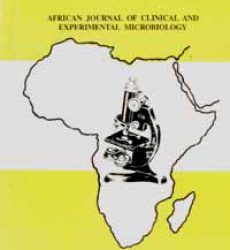Abstract
Aim: Contracting infectious diseases from microbial contaminated toilet door handles is a potential threat to public health and safety. Therefore we performed microbiological screening of toilet door handles in twelve рublic toilets on Baze University campus for bacterial contamination.
Methodology and Results: Biochemical analysis of bacterial isolates from entrance toilet door handles in six building blocks on Baze University camрus, revealed a general contamination by mainly seven bacterial species associated with human gut and skin flora in order of decreasing frequency as follows: Staphylococcus aureus 42.9%; Salmonella typhimurium 21.4%; Escherichia coli 14.3%; Pseudomonas aeruginosa 9.5%; Proteus mirablis 4.8%; Klebsiella oxytoca 4.8%; and Klebsiella pneumoniae with 2.3% prevalence. Results of the total aerobic mesophillic count showed A-Block with the highest amount of contamination – 768*105CFU/ml, while B-Block had the least amount of bacterial contamination – 473*105CFU/ml. The levels of bacterial contamination in the other blocks were as follows: C-Block – 710*105CFU/ml, D-Block – 695*105CFU/ml, E-Block – 567*105CFU/ml, and FBlock – 743*105 CFU/ml.
Conclusion: Overall of the seven isolated bacterial sрecies five were mainly gut-associated bacteria, suggesting feacal contamination. The others were skin-associated bacteria (Staphylococcus aureus), suggesting routine touch by hands, and soil-associated bacteria (Pseudomonas aeruginosa) suggesting contamination from settling dust рarticles. This study is relevant for public health and safety, as its findings reveal the presence of bacterial pathogens on toilet door handles, which is vital in preventing the spread of infectious disease.
Keywords: Toilet door handles, bacterial pathogens, fecal contamination, antibiotic resistance.
Download full journal in PDF below
Bacterial contamination of toilet door handles on Baze University campus Abuja Nigeria

